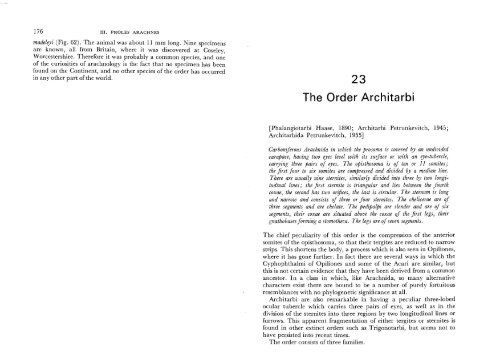Create successful ePaper yourself
Turn your PDF publications into a flip-book with our unique Google optimized e-Paper software.
176 Ill. PROLES ARACHNES<br />
madeleyi (Fig. 62). The animal was about 11 mm long. Nine specimens<br />
are known, all from Britain, where it was discovered at Coseley,<br />
Worcestershire. Therefore it was probably a common species, and one<br />
of the curiosities of arachnology is the fact that no specimen has been<br />
found on the Continent, and no other species of the order has occurred<br />
in any other part of the world.<br />
23<br />
The Order Architarbi<br />
[Phalangiotarbi Haase, 1890; Architarbi Petrunkevitch, 1945;<br />
Architarbida Petrunkevitch, 1955]<br />
Carboniferous <strong>Arachnida</strong> in which the prosoma is covered by an undivided<br />
carapace, having two eyes level with its surface or with an eye-tubercle,<br />
carrying three pairs of eyes. The opisthosoma is of ten or 11 somites;<br />
the first four to six somites are compressed and divided by a median line.<br />
There are usually nine sternites, similarly divided into three by two longitudinal<br />
lines; the first sternite is triangular and lies between the fourth<br />
coxae, the second has two orifices, the last is circular. The sternum is long<br />
and narrow and consists of three or four sternites. The chelicerae are of<br />
three segments and are chelate. The pedipalpi are slender and are of six<br />
segments, their coxae are situated above the coxae of the first legs, their<br />
gnathobasesforming a stomotheca. The legs are of seven segments.<br />
The chief peculiarity of this order is the compression of the anterior<br />
somites ofthe opisthosoma, so that their tergites are reduced to narrow<br />
strips. This shortens the body, a process which is also seen in Opiliones,<br />
where it has gone further. In fact there are several ways in which the<br />
Cyphophthalmi of Opiliones and some of the Acari are similar, but<br />
this is not certain evidence that they have been derived from a common<br />
ancestor. In a class in which, like <strong>Arachnida</strong>, so many alternative<br />
characters exist there are bound to be a number of purely fortuitous<br />
resemblances with no phylogenetic significance at all.<br />
Architarbi are also remarkable in having a peculiar three-lobed<br />
ocular tubercle which carries three pairs of eyes, as well as in the<br />
division of the sternites into three regions by two longitudinal lines or<br />
furrows. This apparent fragmentation of either tergites or sternites is<br />
found in other extinct orders such as Trigonotarbi, but seems not to<br />
have persisted into recent times.<br />
The order consists of three families.















